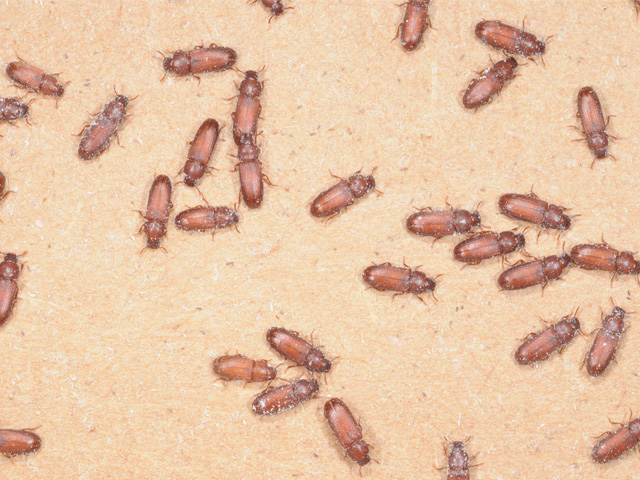Red Flour Beetle, Vol. 5, No.1
Related News
June 29, 2015
June 17, 2015
June 4, 2015

Order: Coleoptera
Family: Tenebrionidae
“We keep finding these little bugs crawling around on top of the kitchen cabinets. What are they and where are they coming from?” These are red flour beetles and they are probably coming from cereal, flour, cookies, cake mix or some similar item stored in the overhead cabinets. Red flour beetles, as well as closely related confused flour beetles, are common pests in kitchens, retail stores, food processing facilities, and grain storage facilities throughout the world. They don’t attack whole grains, but both the larvae and adults thrive on flour and fines produced from whole grains. Remember your grandmother sifting the flour before making her cake? One reason for doing this was to get the bugs out. Back in the day when flour was sold in bulk, or in large cloth bags, flour beetles and other stored food pests were much more common.
Advances in modern processing and packaging have helped to greatly reduce the occurrence of stored food pests. With many food products, that tightly sealed bag inside the box has been specially developed to keep out insect pests, but once the bag is opened, insects can, and eventually will, get inside. Even though red flour beetles don’t feed on whole grains, they still occur in such grains, where they feed on flour and fines resulting from broken grains, and from the activity of insects that can bore into whole grains, like rice weevils and lesser grain borers. Infested food items will often contain more than one species of insect pest. Also, the longer a product is stored the more likely it is to become infested. That half-used box of pancake mix that got pushed to the rear of the upper storage cabinet and forgotten is a prime candidate for flour beetle infestation.
Control: Prevention is the first line of defense against stored food pests. Store susceptible items in bug-proof containers, or keep frozen or refrigerate, practice good stock rotation, and keep storage areas free of crumbs and spilled flour products.
To eliminate an active infestation it is necessary to find and dispose of all infested food items. This usually involves making a systematic search through the pantry, cabinets, and other food storage areas. Keep in mind that there may well be multiple points of infestation and that infestations of stored food insects can occur in areas other than the kitchen. Examples of non-kitchen infestations include: bath flakes stored in a bathroom cabinet, bird seed stored in the laundry room, decorative corn stored in a hall closet, placements of rat bait in the attic, and snacks left in pockets of winter coats or camping gear.
See pages 24-27 of Extension Publication 2443, Control Household Insect Pests for more information on stored food pests and how to prevent or control infestations.
Blake Layton, Extension Entomology Specialist, Mississippi State University Extension Service.
The information given here is for educational purposes only. Always read and follow current label directions. Specific commercial products are mentioned as examples only and reference to specific products or trade names is made with the understanding that no discrimination is intended to other products that may also be suitable and appropriately labeled.